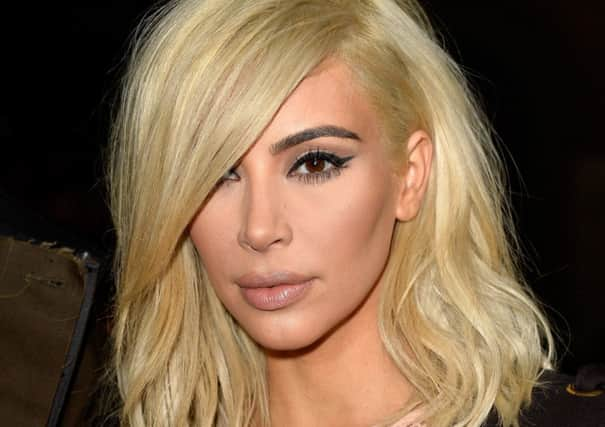Lori Anderson: Kim Kardashian & the bad hair day


This has been a curious week, brunettes have become blondes and blondes have become brunettes. For so long the focus on Kim Kardashian has been on her cartoon derriere but now it has been transferred to her hair which appears to have been industrially bleached, making her look like a new Batman villainess, the Suicide Blonde.
Following in her diabolical footsteps is Claire Underwood, the Machiavellian First Lady in House of Cards who (spoiler alert) has cast aside her glacial Hitchcock blonde colour for a manic pixie cut in a devilishly inky black.
Advertisement
Hide AdAdvertisement
Hide AdI don’t yet know what has precipitated her to hunch over the kitchen sink with plastic gloves and a box of Nice‘n’Easy but it transformed Underwood from Justin Bieber to Marilyn Manson in 15 minutes.
It’s too early to tell if the pair of them are currently enduring their own bad hair day but it was interesting to read that the female mane can trouble even the most rich and successful. Ivana Trump may have declared that “gorgeous hair is the best revenge” but achieving it is another matter.
This week one of the world’s most successful authors detailed her love/hate relationship with her mop. Barbara Taylor Bradford, who is always impeccably coiffed in all her photographs and public appearances, said: “My mood is defined utterly by my hair. It has always been more important than my face, make-up or clothes.
“I could be adorned in the finest jewels and wearing the most exquisite ball gowns, but if my hair isn’t exactly right, I would not be happy at all … I go twice a week to the hairdressers, and on the days in between, I set my hair myself. But as my husband, Bob, knows only too well, the state of my hair affects my entire psyche. If it is perfect, I am lifted, confident and content. It if just doesn’t look right, I can get quite irritable.”
Like many women I’ve had my own tussles with the curling tongs and can take a small degree of comfort in knowing that Barbara Taylor Bradford’s achievements, which include selling 88 million books and earning an estimated fortune of £180 million, can’t stave off the darkness that descends with untamed hair.
Misery loves company and it is comforting to know that we are not alone. A survey in 2012 found that 5 per cent of women have taken a day off work because of a bad hair day and cans of Elnett may have taken to the air as 12 per cent have been tipped over the edge into arguments with their partners.
According to a study by Dr Marianne LaFrance, professor of psychology and professor of women’s and gender studies at Yale University, the “bad hair day” is a quantifiable phenomenon that can affect both sexes although women are more likely to be the victim. She discovered that during a BHD our self esteem is unduly affected and our social insecurities are magnified to the point where self-doubt bleeds into all other aspects of our lives previously untouched by hairdryer, brush or comb.
As Professor LaFrance explained: “Interestingly, both women and men are negatively affected by the phenomenon of bad hair days.
Advertisement
Hide AdAdvertisement
Hide Ad“Even more fascinating is our finding that individuals perceive their capabilities to be significantly lower than others when experiencing bad hair.” The academic study found that the “bad hair day” reduced our self-esteem and even diminished our sense that we were a worthwhile person.
I wonder if Hillary Clinton was aware of Dr LaFrance’s pioneering research when she visited the same university in 2001 to deliver the commencement speech during which she dispensed the following advice to female students: “The most important thing I have to say to you today is that hair matters. Pay attention to your hair, because everyone else will.”
It has always been this way. Martin Luther once said “the hair is the richest ornament of women.”
Martin Luther was speaking in a different time when a woman’s intellect and personality where clearly of little consequence.
Yet down through the centuries women have used their hair to dazzle. Botticelli’s Venus wore her Rapunzel-like flaxen hair like a veil to both mesmerise and conceal and in the 18th century Madame de Pompadour stunned the court of Louis XV with her increasingly elaborate hairstyles and bequeathed her name to the back-combed look that since then has woven in and out of fashion during the past two centuries.
Last week Barbara Taylor Bradford put her finger on a key point on how our hair has become increasingly important to women in recent decades when she quoted Nora Ephron who wrote: “There’s a reason why 40, 50 and 60 don’t look the way they used to and it’s not because of feminism or better living through exercise. It’s because of hair dye. In the 1950s only 7 per cent of American women dyed their hair; today there are parts of Manhattan and Los Angeles where there are no grey-haired women at all.”
We who have lustrous locks or glowing manes should comfort ourselves during a bad hair day with the plight of the follically challenged.
As Larry David said: “Anyone can be confident with a full head of hair. But a confident bald man — there’s your diamond in the rough.”
FOLLOW US
SCOTSMAN TABLET AND MOBILE APPS